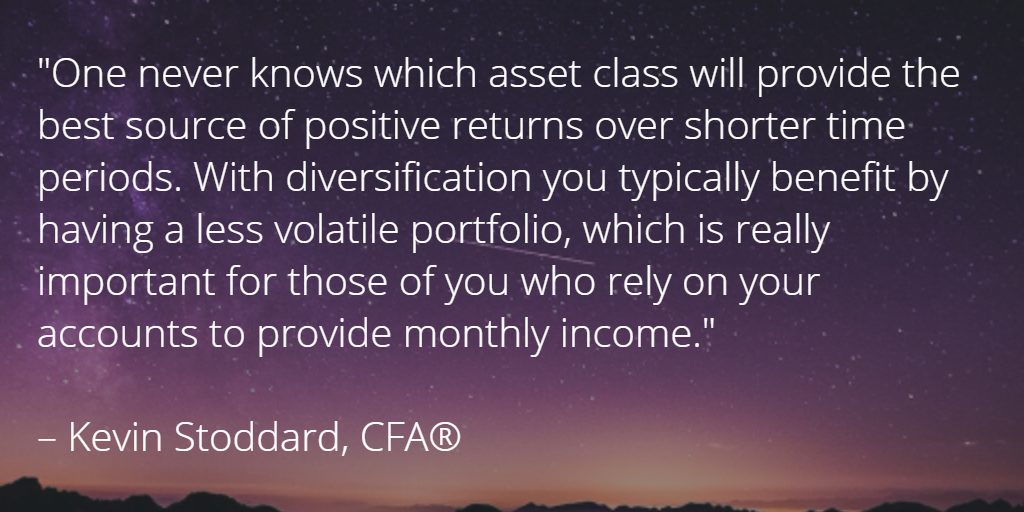
Diversification Pays Off
Last month I wrote a post entitled “The Diversification Conundrum” which highlighted some of the asset class returns that are found in many client portfolios. The main takeaway of that article was that in 2014 the S&P 500 outperformed its 10 year average by more than 4% while 3 other asset classes underperformed their respective 10 year averages by 4% – 15%.
What a Difference a Quarter Makes
Let’s take a look at the asset classes so we can see where we stand now. The stock market was up 13.66% last year but is up less than 1% in the first quarter. International equities were down 4.90% in 2014 — that’s a negative 4.9% — and are up 4.85% this quarter. High yield bonds returned just 2.13% in 2014 and have already beat that by returning 2.27%. And last but not least, senior loans — which are also known as floating rate notes — were up an unimpressive 0.61% in 2014 are still bringing up the rear at 0.25%.
| Index | Q1-2015 | 2014 |
| S&P 500 | 0.95 | 13.66 |
| International Equity (MSCI EAFE) | 4.85 | (4.90) |
| High Yield bonds (Markit iboxx Liquid High Yield index) | 2.27 | 2.13 |
| Senior Loan (Barclay’s US Floating Rate Note) | 0.25 | 0.61 |
Source: ishares.com
Staying the Course
By remaining diversified when it didn’t feel good (2014) and sticking with your allocations, you will see that you directly benefited this first quarter. International equites and high yield bonds each provided more than double the return of the stock market in Q1. This is the main value to staying diversified: One never knows which asset class will provide the best source of positive return over shorter time periods. With diversification you typically benefit by having a less volatile portfolio, which is really important for those of you who rely on your accounts to provide monthly income.
A look back…
The balance of the year will most likely have just as many attention grabbing headlines as we had this first quarter. We have seen oil fall to about $40 per barrel only to recover to the mid $50’s. The US dollar has risen sharply in value, which keeps prices of imports low, but which hurts sales of US products sold overseas. The European Central Bank has their version of the US “quantitative easing” which is helping to keep their interest rates low and provide a boost to European equities… which in turn has helped diversified portfolio returns this quarter.
A look ahead…
Moving forward we could see international equities continue to respond to Central Banks easy money policies around the world. Our own Federal Reserve has been publicly hinting about raising interest rates in the near future. Some economists/pundits think June, some September and even others who think it won’t be until 2016 that we see an increase. I for one would welcome it. It’s a sign of economic strength and confidence in our fundamental economy. It’s high time we savers can get some return on our savings accounts and treasury bonds!
Disclosure:
The opinions voiced in this article are for general information only. They are not intended to provide specific advice or recommendations for any individual and do not constitute an endorsement by LPL Financial. To determine which investments may be appropriate for you, consult with your financial professional. Investments are inherently risky and will fluctuate with changes in market conditions. Indices are unmanaged measures of market conditions. It is not possible to invest directly into an index. Past performance does not guarantee future results. Diversification does not guarantee profit nor is it guaranteed to protect assets. In general the bond market is volatile. Fixed income securities carry interest rate, inflation, credit and default risks. Any fixed income security sold or redeemed prior to maturity may be subject to a substantial gain or loss. The MSCI EAFE Index serves as a benchmark of the performance in major international equity markets as represented by 21 major MSCI indexes from Europe, Australia and Southeast Asia. International investing entails special risk considerations, including currency fluctuations, lower liquidity, economic and political risks, and differences in accounting methods.

























































